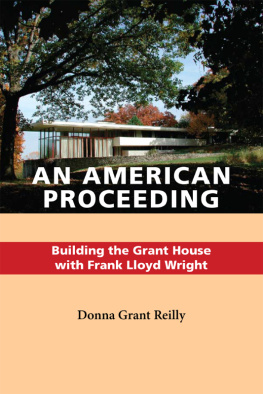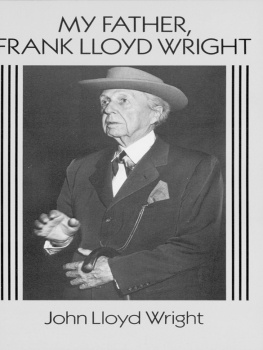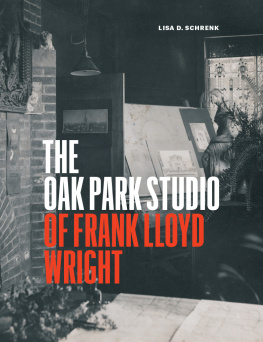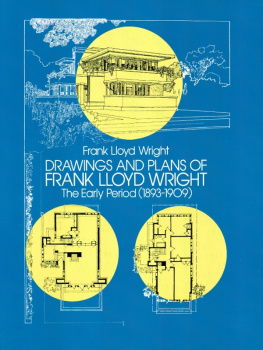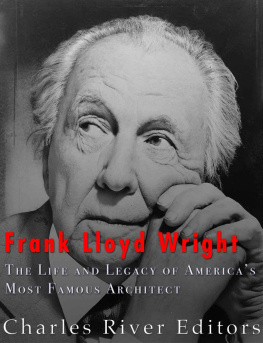My sincere gratitude goes to Bruce Brooks Pfeiffer, at the Wright Foundation, for giving me the impetus I needed to start this book. His assistance, encouragement and generosity have been greatly appreciated.
My thanks go to Pat Tracy for preserving and re-formatting the taped interviews I made with my parents in the late 70s. Although most of the photos in the book come from the Grant family collection, I would like to thank Phil Feddersen for giving me permission to use some of the photos he took during construction. I am particularly grateful to Jack Barrett and Mark Polizzotti for the help and encouragement they gave me during the entire process.
Finally, I could not have done any of this without the support of my husband, Chuck Reilly. He gave me encouragement, thoughtful criticism and helpful suggestions; he must have read the manuscript a dozen times. What is more, he gave me the time I needed and the self-confidence I sometimes lost sight of. And even though I spent many hours in front of the computer, neglecting everything except this book, he continued to give me the time and space I needed to see it through to the end.
FOREWORD
THE DOUGLAS GRANT HOUSE
I believe a house is more a home by being a work of art.
Frank Lloyd Wright, The Natural House, 1954
At the entry on the upper level, to descend inside the long stairway enclosed by massive native stone walls on either side, to the two story living room below, is to lead you into a world of medieval romance, as though you are in a twelfth century French castle, down to a world of present day splendor, into a living room where three walls of glass, fifteen feet tall, reveal to you all the glories of nature in its ever-changing seasons. This is the house that Frank Lloyd Wright designed for Jackie and Douglas Grant.
The most remarkable thing about this house is that it was built, for the most part, by the Grants themselves. Douglas Grant acted as the general contractor, and when a stage of construction was new to him, he sought out books and journals that would teach him the craft and techniques that he needed to go on building. Jackie Grant was on the site from the very beginning in the role of a construction worker, at the same time managing a household and raising three children. Their daughter, Donna, has written an intense account of how this all took place.
This is an American proceeding, building their own house, as Wright described what the Grants had heroically undertaken while the house was still in construction, And they certainly ought to have a house. Theyre all tumbled up in a pile with three children, and the parents, but theyre getting a lot of fun out of that house, I know. It is going to be beautifulThe chimneys finished, and the second story is poured, and now hes busy bending the conduit and putting it in the walls and floors himself. Hes no electrician, never had done anything of that kind before. Hes a radio man, a very bright fellow. If every G.I. had the wit and intelligence to go ahead and build a house the way hes building his, our colleges would be greatly relieved. Yes, pleasing, astonishing to see what he has done.
The journey that the Grants undertook to turn Wrights drawings into a home of their own was fraught with hardships, anguish, and often heart-breaking difficulties. There were problems and disappointments. However, the Grant house ranks among some of the finest and most inspired homes that Frank Lloyd Wright ever designed. Here is a home for the average American family of moderate means. It is in that genre of homes that Wright called Usoniana building for a family in the United States, wherein beauty and repose is possible without ostentation or great wealth. The greater amount of his work was residential, and of his residential work, the greater part of that category was the many homes he designed for middle-income families, such as the Grants. Further, of those homes, this one rightfully takes a special place, unique in Wrights work, due to the design with its companionship to the landscape and the fact that it was primarily built by the clients themselves with much hard work all along the way, but with much determination and devotion.
BRUCE BROOKS PFEIFFER, Director of Archives
Frank Lloyd Wright Foundation
Taliesin West, November 22, 2007
Frank Lloyd Wright to the Taliesin Fellowship, 1950
PREFACE
Throughout the literature on Frank Lloyd Wright and his architecture one finds many stories about the people who lived in the houses he designed for them. Nearly all of them considered it a rare privilege to be among the fortunate number who achieved that distinction.
But there was an even more select group of Wright homeowners, rarely mentioned in any of the literature: a small band of men and women who built their Frank Lloyd Wright homes from the ground updoing all or most of the work themselvesand who were largely unaware of each other. In most cases they had some building experience, and often it was the only way they could afford to build. Apparently, Wright fully approved of these endeavors, once he was satisfied that the job would be done to his satisfaction. The idea of a man building his own house was pleasing to Wright; he liked to tell his clients about the virtues of hard work and how a little sweat would help them to appreciate their house even more.
There isnt much written about the people who built their Wright designed houses with little or no outside help. Most, if not all of them, are gone, and we may never know the full story of how they coped with the experiences they encountered as a result of choosing to build on their own. In 1946, Frank Lloyd Wright designed a house for my parentsMr. and Mrs. Douglas Grantin Cedar Rapids, Iowa. My parents not only did most of the construction themselves, but they quarried the stone that went into the walls. The work was hard and it took them a long time, but their reward was the unique distinction of living in a Wright design to which they had given form.
Wright was also fond of telling his clients that living in one of his houses would change their livesa dramatic statement indeed. But his prediction was one worthy of the Oracle at Delphi; at the time, one didnt stop to wonder if that change would be for better or for worse!
The story of how my parents built their Frank Lloyd Wright house is a remarkable one. I was there when it happened, and I remember it very well. Id like to share it with you.
DONNA GRANT REILLY, March 2010

